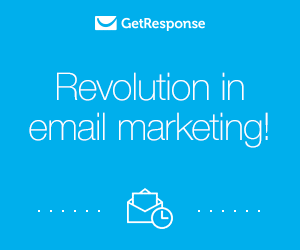Inboxes are typically stuffed. Busy people usually check them a few times a day. And if they are really busy, it’s just easier to scan down and open only those that seem important, are from friends, or are intriguing/engaging in some way. Once an email is opened, moreover, it is often scanned for the “meat.” It may be closed and held for another look later, deleted, or sent to spam.
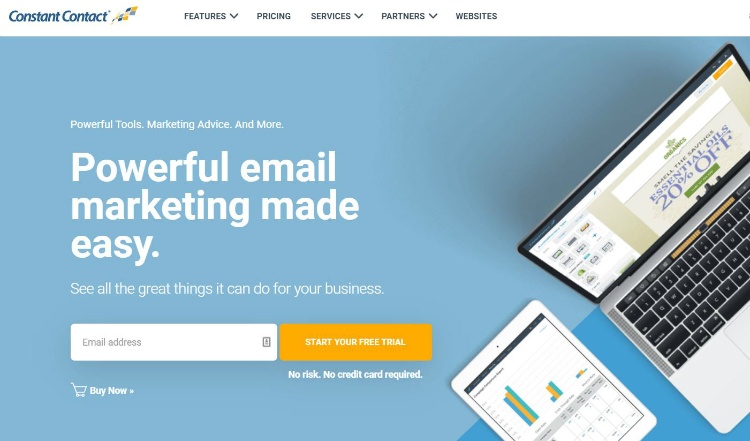
While many marketers have given up on email marketing, your email marketing strategy can be the lifeline of your brand to survive in a competitive landscape. What makes it different from other marketing channels? It can cover many levels of engagement with a client in one shot.
Over the years, countless articles announced the death of email, but it still delivers the best return on investment. The Econsultancy/Adestra 2019 Email Marketing Census reveals that over 70% of respondents find this channel first-rate, compared with paid search and SEO.
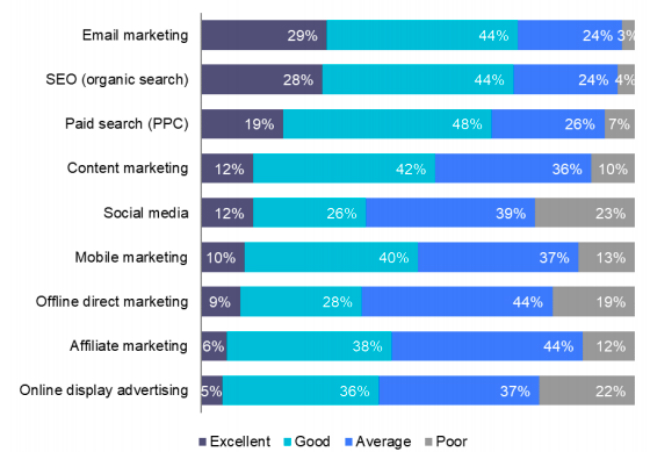
Email delivery rates have grown over the last 3 years, reaching 98%. If in 2015, only 17% of email users opened an email, in 2018 open rates reached 30%.
Email marketing engages the public, educates and grooms them, and it helps you learn their preferences to tailor the content you further provide. However, not all email campaigns achieve opens, responses, and conversions, if the marketer doesn’t get it right.
Optimizing an email marketing campaign isn’t difficult but it does require research, time, and a bit of creativity.
Here are eight things to consider, as you develop an email campaign.
1. One Potato at a Time
This is an old saying, but it holds true for many things, including emails. One of the biggest mistakes that email marketers make is trying to pack too much in a single email. Each email sent should have a single purpose and cover a single short topic, with, optimally, a single CTA, whether that is to access your website, take advantage of a special discount, sign up for a newsletter, etc. If your marketing email is too full of a variety of topics, no matter how small, people become overwhelmed and/or confused.
2. Subject Lines
The importance of subject lines cannot be overstated. These are the first words your recipient will see, and they must build anticipation of what is to follow if they open the email. At the same time, subject lines must be short. Getting the right combination of creativity and brevity can be a challenge indeed, but you must spend time coming up with the best one possible.
The team at Upworthy, for example, spends as much time coming up with titles for their posts/articles as they do on the actual content itself. They understand the importance of engagement and intrigue. You can get help from some online title generator tools, most of which are free to use.
The other key consideration is this: Never use “clickbait,” a tactic to promise something that is not actually delivered once the email is opened. This disappoints, makes you angry, and causes a lack of trust in your brand. It is likely that future emails to that same person will be deleted, or, worse, you will face an “unsubscribe.”
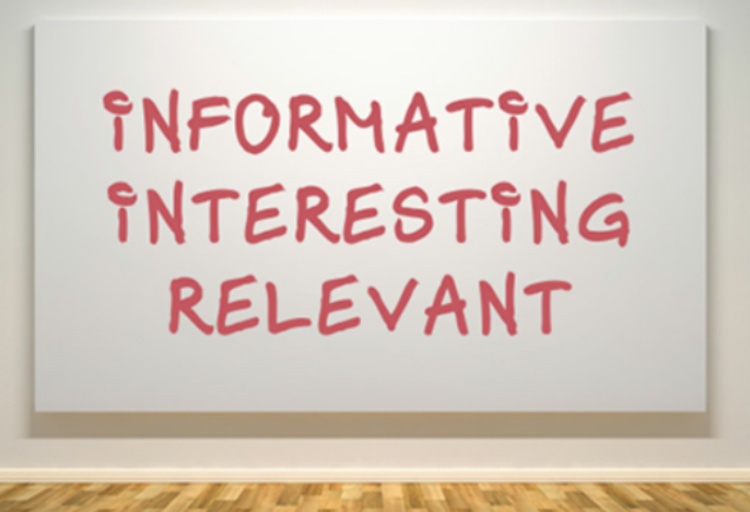
3. Content – Text and Visuals
In short, every email should have some type of visual – photos, videos, memes, illustrations, and even the increasingly popular GIFs. People respond well to visuals, and it’s proven they boost engagement and conversion rates. Studies show that adding images to communication generates a 650% higher engagement rate than text-only posts (no matter if you send emails, post on social media or publish articles in a local newspaper).
Nike does it every time it sends an email.
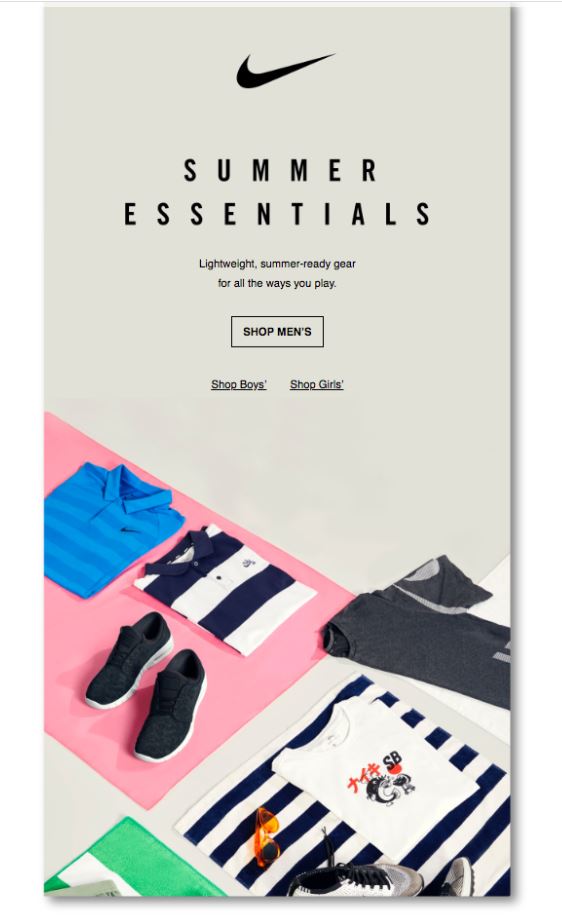
This is not to say that text is not important, but your main message must be short and scannable. If you have more to say on a topic, provide a link to a web page or blog post. This is best done as a CTA button.
Speaking of CTA buttons, these should be separate from your other text, prominently displayed, and in a bright colour.
Another important point: Make sure that your visuals load quickly and that any CTA buttons take the reader quickly to the source. Test these on all email platforms.
Plus, if you want custom illustrations for your email campaigns, you can reach out to illustration services to create those for you. Studies show that adding images to communication generates a 650% higher engagement rate than text-only posts (no matter if you send emails, post on social media or publish articles in a local newspaper).
4. Optimize for All Devices
While the majority of consumers are now checking their emails on their phones, many are still checking them on computers at work or at home in the evenings, on tablets or PCs. Responsive design is the answer, of course. In this way, all recipients will have the same great experience no matter how they have accessed your mail. And be certain that CTA buttons are large enough on mobile devices for a thumb to press. And no user wants to have to enlarge or reduce images in order to see them well. Use a tool like Litmus to see how your email will look before you send it out.
5. Personalization
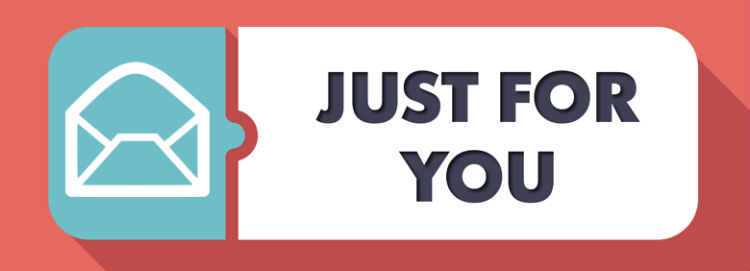
Every email you send out must provide value and be relevant to your recipients. But your recipients have very different wants and needs, and they are in many different places in what we now refer to as a sales funnel. This is why segmentation is so vital to email marketing success.
Perhaps a target has signed up for your newsletter or subscribed to your blog. He is not yet at a point of purchase, only interest. You can group these individuals into a segment and craft emails that will honour those interests. Perhaps you can email a whitepaper or an article you found that is relevant. These keep your brand in their heads without going in for a sale right now, and they come to trust that you have their needs in mind.
Still, another target may have shown an interest in a specific product. He is further along in that funnel and should receive emails that speak to the value and benefits of that item. Such an email might include a short video on how the product is made or a photo/video a happy customer has sent to you.
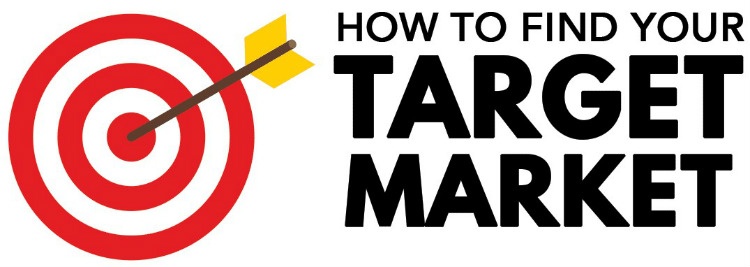
You also have customers who have already made purchases. You want to reward their loyalty with special discounts and sales of a new product in which they may have some interest.
The more segmented your audience is, the more personalized your email will be. Personalization is far more than simply addressing a recipient by name. It is individualizing your relationship with him.
6. Tell a Story When You Can
People love stories. And if they can be entertaining or inspirational, all the better. And when a story also provides the benefits and value of a product, you have a great marketing tool.
There’s no buy it now, it brings you 5 benefits. There’s only a story created around a product that resonates with people’s desires. If you cannot tell a good story about your brand or products, then chances to sell them are greatly reduced.
People connect through the emotional stories they share. When email marketing applies this method, it’s insanely the result it gets.

If you sell pet products, here is an example of an email you can send.
Dear Cat,
It’s National Cat Day, which seems like a great moment to thank you for being daily by my side.
Thank you…
For purrs when I’m sad. And watching Titanic. And eating chocolate. Or eating anything you don’t get because they’re bad for your health.
For watching for the Christmas tree when I’m away from home. You destroyed it, but it’s the thought that counts.
For licking your butt, then sniffing my cake. You’re strengthening my immune system.
For…how majestic of a cat you are. I’ll just say thank you, with treats from Brand.
Get 5% discount for cat treats on National Cat Day
You don’t introduce the offer until the very end of the email, and you keep the focus on the message. You help recipients feel and show gratitude towards their pets, making them more inclined to order treats.
Storytelling can invoke emotions and feelings when used right and convince the recipients to buy without actually promoting them your brand.
7. Split Testing Pays Off

All email marketing campaigns start based on a hypothesis, but to ensure it’s the right solution for your organisation, you need to use split testing. It reveals the optimal solution for the subject line, content, call-to-action, frequency and the send time.
Split testing reveals new things every time you use it.
All email marketing campaigns have a common goal, to get emails opened.
The first step is to ensure the subject line evokes emotions (joy, excitement, curiosity). Recipients don’t open emails with spammy subject lines. Non-profit organizations use this strategy to draw attention to the causes they fight for.
A subject line that would evoke sympathy would sound like this “Help us save animals from Australia’s fires”. It elicits both concerns and needs for action.
To identify what strategy works best with your target audience, test various methods.
Personal lines always get higher open rates. Use the recipient’s name to create a personal subject line. These emails offer the impression they were written especially for the recipient and allow the sender to create a strong relationship with the recipient.
Once you identify the subject line that gets the best open rates, test the type of content your audience appreciates. E-commerce organizations should commit to newsletters.
Including a button as “buy now” to function as a CTA isn’t always the right choice because it can scare a prospect who isn’t ready to buy from you yet. A softer call-to-action would function better. “Visit our website to find more about our discounts.”
8. Get the Frequency and Timing Right
Your subscribers enjoy receiving consistent emails, but no one wants their gym services provider to spam them with messages. Research shows that people unsubscribe from newsletters because the brands send too many emails too frequently.
To find out how often your public considers optimal to receive emails test the list to identify who is engaging with your content.
Engagement is the secret to great deliverability.
To ensure you’re not spamming your subscribers add a section in the email’s footer to ask subscribers how often they want to receive emails, and what type of emails they prefer.
Research what the ideal email frequency is for each industry and find out the factors that decide what the ideal one is for your brand. Factors like the goal of the campaign, the customer purchase lifecycle, audience segmentation, and industry best practices can influence the ideal email frequency. Testing can reveal what works best for your public.
As to timing. Research has shown that the majority of people read their emails during the workday, usually between 8 – 10 a.m., and then again toward the end of their workday, between 3 – 4 p.m., and then there is an increase in opens between 8 – 10:00 p.m.
These times are logical. People are busy getting ready for work in the morning and then commuting. But, once they settle in at their desks, they are ready to check those emails.
At the end of the workday, they are commuting home, fixing/eating dinner, helping kids with homework, getting them bathed and in bed, and then they can sit down and check again.
If you automate sending your emails (and you should), then you can time them to arrive relevantly. For example, you can send them overnight, so they are there for that first-morning open. Again, you should test the timing against opens to find the optimum time.
Wrap up
There’s no one-solution-fits-all method when it comes to email marketing. It’s about trying different methods, different types, segmenting well, and then and identifying what works for your campaigns. The above eight tips and examples should provide you with solid research-based strategies that can help you optimize your email marketing campaign.
Create high-quality emails that engage more and convert faster – you will get good results.
About the Author
Daniela McVicker is a passionate digital marketer. Daniela is interested in everything related to SEO and blogging. She collaborates with many authoritative websites where she shares her experience and helps marketers make their names in the online world. You can check her last Trustmypaper review.


